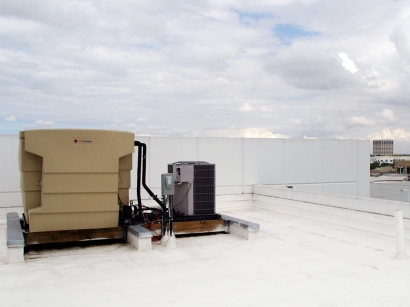Ice Energy cools down power demand
If you’re turning on the air conditioning at home or at the office, you’re probably wasting electricity. But you don’t have to sweat to go green, you can just use thermal energy storage.
Windsor, Colorado based Ice Energy turns standard air conditioning systems into ice makers at night.
"It’s a storage module that’s designed to work with literally hundreds of millions of rooftop packaged air conditioners and down to residential central air conditioners," Greg Tropsa, president of Ice Energy.
While thermal energy storage is not a new concept, making a product that can work with small to medium sized business and homes is a recent innovation.
"That’s part of the secret of the technology, to leverage the very large number of channels and manufacturers that are out there, and complement that industry."

It’s a technology that’s caught the attention of investors, with Ice Energy pulling in $25 million in a Series A financing in May. Goldman Sachs led the round, with cash also coming from Good Energies, Second Avenue Partners and Sail Venture Partners.
Goldman Sachs recently installed a large-scale chilled water cooling system at its New York headquarters.
In addition to financing, Ice Energy also got a boost when a California utility promoted the Ice Bear system for its $10 million incentive program to reduce peak demand.
"With a large company like PG&E offering a program around our technology, it creates a very large market opportunity," said Tropsa.
In September, PG&E (NYSE: PCG) said it would offer upfront rebates and annual incentives to its customers if they add the ice storage system to existing and new air conditioning equipment. Ice Energy said its system can shift up to 95 percent of air conditioning load to off peak hours while providing full cooling performance.
So how does the system work? Ever notice the ice that builds up on the coils of an air conditioner or refrigerator? The Ice Bear system stores that ice, made from a tank full of 570 gallons of tap water, and uses it during the day to compress the refrigerant.
"You’ve got what’s called an evaporator coil. And what the evaporator coil does is that the refrigerant, the liquid, goes into the coil and it expands into a vapor, and that phase change from a liquid to a vapor actually draws the heat out of the air, and is part of that thermodynamic process," explained Tropsa.
The tough part comes when air conditioners move that vapor into the compressor. The compressor, under a great amount of pressure and force, turns that refrigerant back into a liquid, ejecting the heat. The heat gets vented to the outside.
"Because it runs off of a pressure or temperature differential, the hotter it gets outside, the harder it is to eject that heat. So, for every degree, it increases the amount of energy that that air conditioner consumes," he said.
In the Ice Bear system, the compressor only runs at night to help make ice, when it’s cooler and it doesn’t have to work that hard.
During the day, a small 150 watt pump sends the refrigerant through coils in the stored ice. When the vapor hits the ice in the coil, it condenses back into a liquid. It ejects the heat, which is now absorbed by the ice, making it melt.
"Because it’s sinking it into the ice, we don’t care if it’s 90 degrees out, or 112 degrees out, it’s always a constant temperature. It’s the most efficient way to cool your home," said Tropsa.
Ice Energy’s products are currently only available in California, Hawaii, and Northern Colorado, but Tropsa sees that expanding in the future.
"The target for the business, as we get to be adopted by the market, is to achieve hundreds of thousands of units per year," he said.
Tropsa said the company has a pilot plant, but that as it scales up, "We have relationships with large, contract, multinational partners that will be manufacturing the unit."
Even without rebates or incentives, Tropsa said the Ice Bear system, which costs around $166 per kilowatt hour, would pay for itself after 9 years. That number is cut down to 2 years or less with incentives like the ones that PG&E is offering.
"With most commercial establishments, they need air conditioning because they generate a lot of heat internally, either people or equipment or cooking," said Tropsa.
He said companies could get up to three or four points in the Leadership in Energy and Environmental Design (LEED) Green Building Rating System by using the Ice Bear system.
Utilities are keen on the new technology as it can relieve their need to build more plants. According to the California Public Utilities Commission, permanent load shifting technologies can offer added protection against shortages during heat waves and reduced reliance on the construction of new generation plants.
"All of the options going into the future for new sources of power are incredibly expensive, and what it does is it makes everything on the energy efficiency, on the demand side, on the non-fossil fuel side, like solar or wind, very much in the money," said Tropsa.
"There are many moving forces in the market right now that create a very exciting time for cleantech."
You can return to the main Market News page, or press the Back button on your browser.

